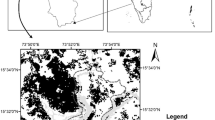Abstract.
Mangroves are climax formation of hydrohalophytes inhabiting estuarine or marine salt marshes in the tropics and subtropics. As a terrestrial plant community inhabiting tidally inundated estuarine or marine sediments, mangroves show considerable adaptation to salinity, water-logging and nutrient stress. Thirty-one species of mangrove and mangrove associates and 23 species of transported flora, belonging to 25 families at four physiographic stages of succession of the mangrove plant community at the terminal part of the Ganges river estuary in India were examined for arbuscular mycorrhizal (AM) root association. Dominant members of the mangrove plant community were all AM, mostly with 'Paris' type structures. Many of the known non-mycotrophic plant families, except the Cyperaceae, also showed AM association, with intracellular hyphae and vesicles as the most discernible endophyte structures. Intensity of AM colonization varied both with the species and situations of their occurrence, being more intense and also more extensive in less saline dry ridge mangroves than in more saline formative and developed swamp mangroves. Introduced exotic trees on the ridges and embankments were infected by AM, but less than the declining mangroves in the same location. Seven species of AM fungi in common with those of the upstream mesophytic plants were isolated from root-free rhizosphere soils of the mangroves, three of which predominated in root association. These species, individually and as mixtures, infected roots of salinity tolerant herbs and trees in both locational silt and upstream alluvial soil with obvious improvements in their biomass yield and phosphorus nutrition. AM infective potential of root-free rhizosphere soils of the dominant members of the mangrove community were negatively related to salinity level of the sediment soil of the successional stages. The evidences of AM association of mangroves and other salt marsh plants obtained here and those reported elsewhere are discussed.
Similar content being viewed by others
Author information
Authors and Affiliations
Additional information
Electronic Publication
Rights and permissions
About this article
Cite this article
Sengupta, A., Chaudhuri, S. Arbuscular mycorrhizal relations of mangrove plant community at the Ganges river estuary in India. Mycorrhiza 12, 169–174 (2002). https://doi.org/10.1007/s00572-002-0164-y
Received:
Accepted:
Issue Date:
DOI: https://doi.org/10.1007/s00572-002-0164-y




